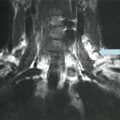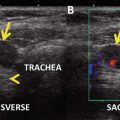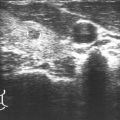© Springer International Publishing Switzerland 2016
David S. Cooper and Cosimo Durante (eds.)Thyroid Cancer10.1007/978-3-319-22401-5_22. A Case of a Small (1–2 cm) Papillary Thyroid Cancer in a Young Patient: Lobectomy Versus Total Thyroidectomy
(1)
Department of Surgery, Boston University, 88 East Newton St, Collamore Suite 500, Boston, MA 02116, USA
Keywords
Thyroid cancerPapillary thyroid cancerSmall thyroid cancerBRAFThyroidectomyRadioiodineThyroid hormone suppressionThyrotropinTSHCase Presentation
A 35-year-old woman was referred to a thyroid clinic due to a newly identified palpable nodule in the left thyroid lobe. She had no history of neck surgery, voice changes, prior thyroid nodules, significant radiation exposure, or family history of thyroid disease. Physical examination included a palpable firm left thyroid nodule, a normal voice, and no cervical adenopathy. Thyroid ultrasound confirmed that the palpable nodule was a solitary hypoechoic 18 mm left thyroid nodule with irregular borders and scattered microcalcifications. A formal ultrasound nodal survey showed no abnormal lymph nodes, and fine needle aspiration cytology of the dominant nodule revealed papillary thyroid cancer. Molecular testing of the FNA sample showed no BRAF mutation. After discussion, the patient elected a strategy of left thyroid lobectomy with intraoperative node assessment, including a planned intraoperative switch to total thyroidectomy and level 6 node dissection only if there were higher-risk features detected during the procedure, such as gross lymph node metastases. The operation was an uncomplicated left thyroid lobectomy under local anesthesia with sedation done as an ambulatory procedure. At 8-week follow-up, her TSH without exogenous thyroid hormone was 1.1 mU/L, and thyroglobulin was 1.8 ng/mL without antithyroglobulin antibodies.
Assessment and Literature Review
Small papillary thyroid carcinomas are very common and rarely threaten long-term survival, especially in young people, unless associated with some poor prognostic features. The management strategy for this common tumor requires coordination of the plan prior to operation, in order to ensure that the procedure performed supports the intended adjuvant therapies and follow-up surveillance.
Prognostic Features
The 2009 version of the ATA thyroid cancer guidelines proposed a three-tiered recurrence risk stratification system that classified patients as low, intermediate, or high risk; this system is being modified in the proposed update to the ATA thyroid cancer guidelines that is in current development [1]. The pathological features that increase the risk of recurrence include vascular invasion by the tumor, invasion of tumor into tissues outside of the thyroid capsule, clinically apparent lymph node metastases, or aggressive histologic features. The implications of V600E BRAF mutation in the tumor are not yet clear, especially for small primary tumors [2]. The findings during treatment that increase the patient’s risk of recurrence include the presence of local or distant metastases on postoperative radioiodine scan or other imaging modalities and a persistently elevated serum thyroglobulin. High-risk pathological features include gross extrathyroidal extension or incomplete tumor resection; distant metastases, thyroglobulin levels that suggest distant metastases, large node metastases (>3 cm), and extranodal extension are other high-risk findings. These features have been shown to predict recurrence risk and can therefore be used to inform patients and clinicians who are choosing treatment and follow-up plans, rather than basing those plans solely on predictions of survival [3], which is typically unaffected in low-risk patients.
The ATA initial risk stratification also predicts the type of persistent or recurrent disease pattern observed; most persistent disease in low-risk patients is solely an abnormal serum thyroglobulin level without structurally identifiable disease which is unlikely to lead to disease-related morbidity. Greater proportions of intermediate- and high-risk patients who have persistent or recurrent disease have clinically or radiologically identifiable structural disease and have a greater likelihood of disease-related morbidity or mortality.
Management Strategies
The operation for thyroid cancer is the initial step in the treatment strategy and follow-up plan established by the managing team. In the past, total thyroidectomy has been promoted as the optimal option for papillary thyroid cancers greater than 1 cm. There are data showing that total thyroidectomy leads to decreased recurrence rates and improved survival [4], as well as optimally positioning the patient for subsequent follow-up using serum thyroglobulin measurements. However, there are also data to support more limited thyroid resection as an equivalent strategy for patients with low-risk disease [5]. As a selective approach to RAI ablation has become more favored in low-risk patients, the utilization of total thyroidectomy specifically as preparation for the use of RAI in treatment or follow-up has become a less important rationale. If a patient population can be identified that has equivalent long-term disease outcomes with thyroid lobectomy , without radioiodine therapy or TSH suppression, then they would best be served by limiting the aggressiveness of treatment, minimizing adverse events, and maximizing quality of life. This is a very important clinical issue, since patients with very low-risk thyroid cancer comprise a very large proportion of the thyroid cancer population [6].
A bilateral thyroidectomy (total or near-total) is preferred if the treatment strategy is to include RAI scanning or therapy postoperatively. This is most clearly applicable to the high-risk groups. For patients at intermediate risk, either a bilateral or unilateral thyroidectomy may serve as the surgical platform for an overall treatment plan. Features that place the patient at increased risk of recurrent disease or of concomitant contralateral disease, such as age >45 years, contralateral thyroid nodules, known multifocal cancer in the lobe to be operated upon, a personal history of radiation therapy to the head and neck, or a family history of differentiated thyroid cancer, may inform the decision to employ a bilateral procedure to preserve the option of RAI scanning or therapy or to resolve questions of bilateral disease. It is clearly in the patient’s best interest to work with a treatment team that can coordinate this decision-making prior to the initial operation, to avoid awkward planning compromises at later points in the treatment course [7].
Stay updated, free articles. Join our Telegram channel

Full access? Get Clinical Tree






